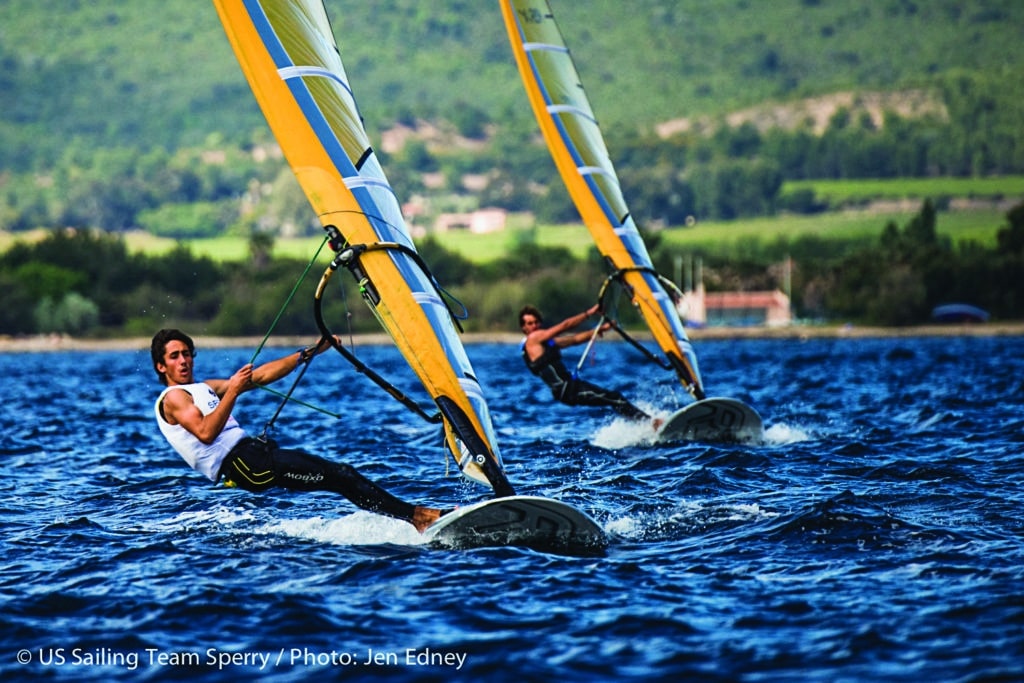
Pedro Pascual was born for racing windsurfers in the Olympics. He just didn’t know it until a year ago. That’s the gist of his windsurfing career, which is now, to his surprise, his full-time gig.
The 20-year-old Pascual had a big year in 2016. He qualified the United States for the RS:X men’s class for the Rio Olympic Games, and along the way nabbed the top spot on US Sailing Team Sperry, earning his ticket to this summer’s Games. His path to a berth has been a challenging one, and despite a virtually nonexistent RS:X racing culture in the United States, he likes his chances for a medal, at least for 2020.
“There was never a single moment where I decided to try for the Olympics,” says Pascual, who moved to the United States two years ago from Seville, Spain. “There was a process. I love sailing. I started on weekends, having fun, learning and then racing. I just kept doing it and never thought about full-time sailing.”
Before the 2015 Sailing World Cup Miami, Pascual was a mess. He was recovering from an injury and cramming for mechanical engineering tests at Florida Atlantic University. He sailed the event anyway and finished just behind a former Olympian. “Even with all that going on, I did better than I thought,” he recalls. “I told myself, if I started full-time sailing, I could go to the Olympics. I did it and it became addictive.”
Pascual stepped on his first windsurfer at 14. He was a tall, skinny kid, and there were others to play with on the water. Success came easily in racing as he reached the historically magical combination of height and weight in the RS:X: 6-foot-1 and 160 pounds.
“I have the perfect body type,” Pascual says, referring to his “light with leverage” attributes. “At the same time, you need physical strength and endurance.” This endurance is put to the test no matter the wind conditions in the RS:X, because kinetics rules limiting the pumping of sails were removed several quads ago in Olympic windsurfing.
Though the young windsurfer has made a science out of his board mechanics at this point, he says he’s missing the power needed to pump the sail in light winds effectively and to stand up to the massive loads generated by the same rig, such as when the anemometer hits 20 knots and the RS:X starts levitating, with only its skeg and a few inches of board in the water.
His lack of power was evident at Sailing World Cup Hyeres in April, when the spring winds nearly flattened the fleet at times. Placing 38th of 40 competitors was a shock, and having trained for only a year, Pascual learned that time on the water isn’t the only factor in a successful campaign. “Hyeres wasn’t that good,” Pascual recalls. “I was doing a lot of paperwork for my planned training in Brazil. I was getting calls while I was out racing. I was trying to do both at the same time.”
Shaking off his Hyeres experience, Pascual is starting to see what it takes to become an Olympic-caliber athlete. In the RS:X, it means managing the extreme, grueling regimen of hanging off the booms, arms fully extended and shoulders rolled forward, then fighting to rapidly thrust the sail toward the body for nearly an hour at a time.
According to a Royal Yachting Association study, in less than 12 knots of wind, RS:X sailors perform for 30 to 45 minutes at 90 to 95 percent of their maximum heart rate. The report also states that the average heart rate for downwind legs nears “maximum values.”
“I don’t think about the pumping much because it’s natural to me,” says Pascual, who believes, though some don’t consider the practice “true” sailing, that it is necessary to provide decent windsurf racing in 4 to 30 knots of wind. He explains the torture of an RS:X race by referring to a quote from New Zealand Olympic windsurfing gold medalist Barbara Kendall, who once said, “Windsurfing is like being on a rowing machine for 45 minutes going as fast as you can, whilst playing chess.”
Being in the elite physical shape needed to sail an RS:X at this level, however, is only part of the equation for Pascual. At the moment, this area of his training is the key to opening up other elements of the game. “All the training now is focused on having the best physical ability and to make it happen naturally so I can focus on tactics and decision making,” he says.
Though he had thoughts about the Olympics three years ago, when he assumed the RS:X, he says his impressions are different now. “After a year of training, I can see myself in four years winning a medal,” he says before pausing and laughing about life post-Games. “After the Olympics, the level drops down, but I want to keep training. And maybe take school online. I can see myself capable of doing better.”









